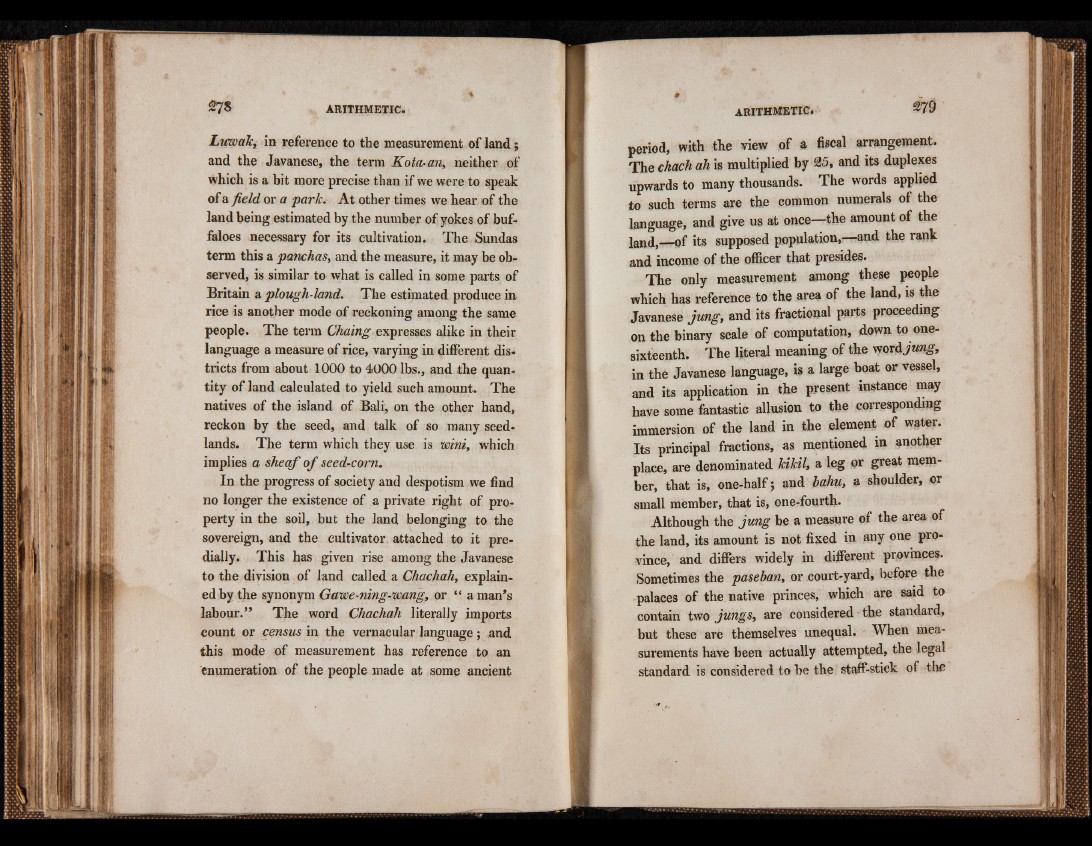
Luwak, in reference to the measurement of land;
and the Javanese, the term Kota-an, neither of
which is a bit more precise than if we were to speak
of a field or a park* At other times we hear ¡of the
land being estimated by the number of yokes of buffaloes
necessary for its cultivation. The Sundas
term this a panchas, and the measure, it may be observed,
is similar to what is called in some parts of
Britain a plough-land. The estimated produce in
rice is another mode of reckoning among the same
people. The term Chaing expresses alike in their
language a measure of rice, varying in different districts
from about 1000 to 4000 lbs., and the quantity
of land calculated to yield such amount. The
natives of the island of Bali, on the other hand,
reckon by the seed, and talk of so many seed-
lands. The term which they use is wini, which
implies a sheaf o f seed-corn.
In the progress of society and despotism we find
no longer the existence of a private right of property
in the soil, but the land belonging to the
sovereign, and the cultivator attached to it pre-
dially. This has given rise among the Javanese
to the division of land called a Chachah, explained
by the synonym Gawe-ning-ivang, or “ a man’s
labour.” The word Chachah literally imports
count or census in the vernacular language; and
this mode of measurement has reference to an
enumeration of the people made at some ancient
period, with the view of a fiscal arrangement.
The chach ah is multiplied by 25, and its duplexes
upwards to many thousands. The words applied
to such terms are the common numerals of the
language, and give us at once—the amount of the
land,—of its supposed population,—and the rank
and income of the officer that presides.
The only measurement among these people
which has reference to the area of the land, is the
Javanese jung, and its fractional parts proceeding
on the binary scale of computation, down to one-
sixteenth. The literal meaning of the word jung,
in the Javanese language, is a large boat or vessel,
and its application in the present instance may
have some fantastic allusion to the corresponding
immersion of the land in the element of water.
Its principal fractions, as mentioned in another
place, are denominated kikil, a leg or great member,
that is, one-half ; and hahu, a shoulder, or
small member, that is, one-fourth.
Although the jung be a measure of the area of
the land, its amount is not fixed in any one province,
and differs widely in different provinces.
Sometimes the paseban, or court-yard, before the
palaces of the native princes, which are said to
contain two jungs, are considered the standard,
but these are themselves unequal. When measurements
have been actually attempted, the legal
standard is considered to be the staff-stick oi the